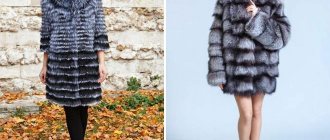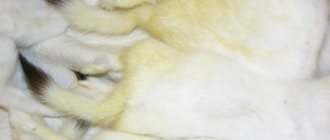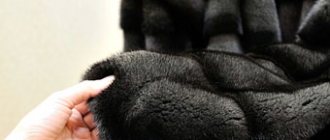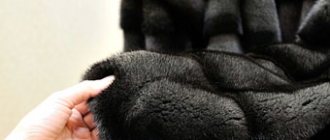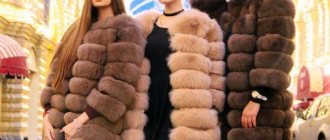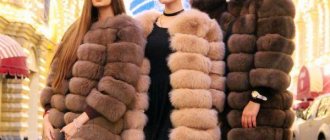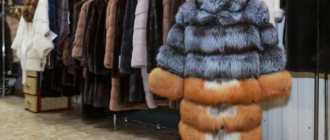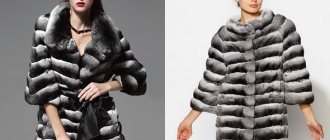You can often hear: “I bought myself a silver fox fur coat” or “I want a beautiful silver fox.” Yes, and stores sometimes sin with this term. But you won’t find silver fox products in the assortment of the KALYAEV chain of stores. Does this mean that we have a poorer assortment? Of course not, it’s just that we, as not only a seller, but also a manufacturer of fur products, are accustomed to using the correct terms. So who is this silver fox?
The term “silver fox” is used not only by buyers, but also by not very competent sellers, to describe the fur of a silver-black fox. But the fur coats made from black-brown foxes are by no means the most beautiful, and they don’t even make fur coats from them. However, first things first.
The fox is a member of the carnivorous order (Carnivora), the canine family (Canidae) and the genus of foxes (Vulpes). One of the most common species is silver-black; they were brought to our country in 1927. This species is a mutation of wild red foxes that live in North America.
The main color tone of silver-black foxes (as, in fact, is clear from the name) is bluish-black. There are variations up to dark brown, but such shades are considered less successful. The silvery color is given by zoned white hairs located on the back and sides. There is such a thing as the percentage of silver, which depends on what part of the skin is occupied by silver hair.
It is thanks to this complex noble coloring, as well as the high hairline with a silky sheen, that the fur of the silver-black fox is so beautiful. However, designers also love it because the fur is easy to dye in bright colors, and the result is incredibly impressive, with tints ranging from intense (where the hair was white), slightly shaded by the dark underfur, to radical black at the tips hair.
Designers have also fallen in love with bleaching (also called “gilding”) silver-black foxes. After the procedure, the gray down acquires (depending on the dyeing conditions) a color from dark yellow to creamy white, and the black tips turn into chestnut or light brown, the white part of the hairs turns slightly yellow. Another option that has been used more recently is partial bleaching.
Well, okay, but where are those black-brown foxes, don’t they exist at all? Of course they do. But their fur does not look at all like the luxurious one that is usually called the silver fox, but much simpler. It's all about the yellow pigment, which silver-black foxes do not have, but black-brown foxes do, and which violates the harmony of black and white contrast. That is why the former have almost completely ousted the latter from the fur industry, and it is impossible to find products actually made from silver fox fur in the store. The only exception is the result of crossing silver-black and black-brown foxes; this color is called “bastard”, and it looks very impressive.
So, what’s so scary, you ask, that a silver-black fox is called a black-brown fox? Of course, there is nothing terrible here - after all, in any case, you are dealing with fox fur, and there is no deception, it’s just that if it is normal for the buyer not to know such subtleties, then a qualified seller should use the correct terms.
We are for calling everything by its proper name. Well, and for beautiful fur coats on happy women, of course!
Every fashionista dreams of a silver fox fur coat . But before purchasing an expensive piece of clothing, you need to familiarize yourself with the selection rules and evaluate all the pros and cons of a fur product.
Silver fox is a term used to describe the skin of a silver-black fox of a noble color with a high pile and a silky sheen. The silver fox lends itself well to coloring and cutting.
By what criteria to choose?
Before purchasing, you need to determine for yourself which factors are most important. Should a fur coat be primarily beautiful or warm? Will it last longer or cost less?
A silver fox makes a reliable fur coat that looks luxurious and richer than mink, since the animal’s fur is long and thick. Attracts admiring glances. The fur is soft and very pleasant to the touch. Other products besides fur coats are made from silver fox, for example, fur vests that go perfectly with leather jackets. Such products have long been loved by Russian fashionistas. Vests are cheaper than fur coats, but they last a long time and provide excellent warmth in frosty weather.
The skin of the Arctic fox is similar in appearance to the fur of the silver fox, it is just as soft and warm. The pile has a thick root that is slightly curled. The natural color of fur is white and blue. A snow-white fur coat constantly attracts the attention of others, but it is not always practical, which is why arctic fox fur is often dyed.
Blue or smoky shades are much less common, which is why they cost more. Vests and hats are made from the skin of this animal; they are no less popular among consumers.
The most expensive sable fur coats: “soft gold”
Many experts call sable clothing the most expensive fur coat in the world. This fur-bearing animal rightfully deserves this title, because its fur is truly valued very highly due to many positive characteristics not inherent in other materials.
The skins of the Barguzin sable are valued much higher than other types of this fur-bearing animal.
The most expensive fur coat in the world is considered to be a product made from this fur, which has been highly valued since the times of Rus'. It stands out favorably in its texture and color scheme among the whole variety of natural materials used in sewing women's fur coats.
In the photo, the most expensive fur coat made from Barguzin sable leaves no doubt that this material can be used to create products of incredible luxury and high cost:
The fur coat has a dark chocolate color with a noble silver tint, which is characteristic of the natural color of this fur-bearing animal.
In the world of fur, sable pelts are often called “soft gold.” They received such an unusual name for their colors, softness and high cost. According to experts, only gold is more expensive than sable skins.
The price of this most expensive fur in the world is quite high; a knee-length fur coat costs approximately 60 thousand dollars.
Similarities
Before asking the question which is better - an arctic fox or a silver fox, you need to decide which criteria are most important when choosing. The arctic fox and the silver fox are similar in some respects. They have the same price range if the fur is not dyed. Otherwise, a fur coat or hat made from silver fox will be more expensive.
The skins of these animals have thick and long pile, which means that they provide excellent warmth in the cold.
The variety of models is amazing for both types of fur. Designers love the fur of these animals, so it will never go out of fashion.
Mink coats: expensive and popular fur
If you ask which fur is the most expensive in the world, given its popularity, then mink takes first place. Many people call this material ideal in terms of price and quality ratio. Probably no other fur-bearing animal can compare with the lightness and durability of mink fur. In such a luxurious fur coat, a woman always looks elegant and presentable, and she will have this look even after 10 years of using her favorite product.
In the last few years, mink fur has become the subject of design experiments. It can be processed in different ways - cut, plucked, bleached, dyed, combined with other materials. As a result of this work of specialists in the fashion world, new and original styles of expensive outerwear appear.
Difference
If we compare reviews from owners of fur coats made from these animals, the main difference is the color. The silver fox has an uneven color, varying from the root of the pile to the tip (from gray to black). There are only two types of natural fox skins, so they are often dyed, although this does not affect the quality of the fur.
Another difference is wear resistance. The Arctic fox is warmer and lasts longer. The silver fox looks better, practically does not stain, but is less warm and can be worn for no more than five seasons.
Fur coats, vests and hats made of Arctic fox and silver fox are very popular, look good in appearance, and retain heat perfectly. It is worth looking at several options to choose a product to your liking.
At first glance, it may seem difficult to distinguish between the fur of an arctic fox and a silver fox. Both of them are widely used in winter outerwear and are loved by designers and women for their chic appearance and comfort. If you have ever wondered how the arctic fox differs from the silver fox, then our article is especially for you.
Vicuna is the most expensive fur in the world
Vicuña is indeed the most expensive fur for a fur coat, but outerwear is rarely made from this expensive material, because not everyone can afford such a luxury. Vicuña belongs to the genus of llamas, it is found in Peru, where this animal is considered the most valuable, one might say, even holy. There, on the country's national emblem you can see the image of a vicuña.
Animals live in the highlands, where it is always cold and windy, so they are well adapted to such harsh weather conditions. In the mountains, the vicuña survives thanks to its warm and thick fur.
Vicuna fur is valued for its softness; the skins themselves are very thin and warm, so outerwear made from this material, regardless of style, is characterized by lightness. Products made from vicuna look elegant and luxurious; previously only noblemen wore such fur clothes.
Nowadays, fur coats are rarely made from vicuna fur; the animal’s wool is used to produce high-quality fabric that resembles cashmere. There is no doubt that this is the most expensive fur in the world, because a meter of such fabric costs 3–5 thousand dollars. Due to such a high cost of raw materials, only famous brands make clothes from it. A fairly wide range of magnificent vicuna fur coats can be seen in the collections of the Loro Piana fashion house.
Comparison
The main visual difference of the silver fox fur is its uneven color along its entire length. It varies from light gray, almost white at the roots to charcoal, black at the tips. Such a naturally unusual, recognizable and beautiful color is not usually adjusted when creating fur products. In turn, the Arctic fox has a more uniform color along the entire length of the pile. Its fur can be white, smoky gray, or brown. Arctic fox skins are often dyed.
Arctic fox fur coat Silver fox fur coat
Being a northern animal, the Arctic fox has warmer fur. In addition, fur coats and accessories made from it are more durable and wear-resistant. They are less picky about storage. Silver fox is sometimes classified as an elegant fur that is not intended for everyday active wear. Indeed, fur coats, coats and vests made of such material look very impressive with evening dresses. However, it is quite possible to wear a silver fox on weekdays. The only important difference will be that such a fur coat will last you about 5 seasons, and an arctic fox coat - no less than 7-9.
In general, when it comes to choosing between these two types of materials, the determining factor is often the individual taste of the fashionista.
Fur coats and hats made of fur have been in demand at all times. These wardrobe items not only warm their owners, but also emphasize their status.
Today, clothing is increasingly being made from faux fur. This material is more affordable and has an external resemblance to natural fur. Sometimes unscrupulous sellers take advantage of this. Let's look at how to distinguish a natural Arctic fox from a fake
pros
A fur coat made from solid plates is very warm and cozy . This one is not very suitable for wearing in the damp winters of the southern regions. Rain and dampness will lead to damage to the product and yellowing. And the sun's rays will quickly affect the appearance of the skins. They may lose their shine and brightness.
Despite the precautions, this expensive outfit has many advantages:
- Soft, warm fur with high pile will provide comfort in the most severe frosts.
- In cold weather, the fur becomes fluffier.
- The silver coloring of the fur gives the product a noble appearance . Coats and capes made of silver-black fox fur in combination with evening dress give the look the charm of luxury.
- Durability. A product made from high-quality natural fur with proper care will last up to 8-10 seasons .
- A silver fox fur coat makes the silhouette of fragile fashionistas more feminine and attractive.
To make sure that an expensive purchase is worthwhile, it is important to evaluate not only the advantages, but also the disadvantages. And based on these aspects, make your final choice.
What types of Arctic fox counterfeits are there?
Most often, expensive fur is counterfeited. They are trying to replace it with cheaper skins:
- Sometimes they try to pass off the fur of one animal as another. The most common fake is mink. After simple manipulations, the fur of a rabbit or arctic fox takes on a look similar to mink;
- Fur pelts are sorted before they go into production. The highest quality and most expensive ones are used to manufacture luxury products.
Unscrupulous manufacturers are trying to improve the appearance of rejected fur and make it look like it is of high quality. In this case, the fur will be natural, but the cost of the product will be much higher.
It is almost impossible to replace the arctic fox with the fur of another animal, since it has a fairly long and fluffy pile. Therefore, it is replaced with synthetic materials. Faux fur is preferred by animal rights activists, and such products are also purchased by those who cannot afford a natural fur coat.
If you want to buy a product made from natural fox, then the first thing you should pay attention to is:
- fur appearance. If it is of animal origin, then under different lighting conditions the color of the pile will change somewhat. In bright light, real fur begins to shine, but artificial material becomes matte, its color does not change depending on the lighting;
- product weight. Natural fur is very light; modern processing technologies can significantly reduce the weight of fur coats made from real fur. Faux fur is heavier;
- You can try to burn a few fibers by first pulling out their products. Natural lint will burn, leaving ash. This will create a characteristic smell of burnt hair. The synthetic fiber melts, after it burns, a single dense lump is formed and the smell of burning plastic is formed.
Faux fur is created by attaching individual synthetic fibers to a fabric base. You can see it if you push the pile apart with your hands or simply look under the lining.
Fur coats: how not to buy a fake that you’ve been saving for for so long, watch the video:
Fur is such a diverse, beautiful and unique material that it is impossible to immediately determine which one you like best. There are types of skins that are superior to others in many qualities - warmth, appearance and quality of pile. Among them are mink, arctic fox, red fox and silver fox, sable, raccoon and many others. But how to choose fur when you plan to buy only one fur coat?
Most often, women cannot choose between the Arctic fox and the silver fox. These two types of fur have a long pile of unprecedented beauty and a bewitching appearance. Let's try to find out which is better: the arctic fox or the silver fox?
The Arctic fox has soft and very warm fur. It is easy to determine by its thickness and volume. The level of wear resistance is incredibly high, the wear period reaches 10 seasons. The structure of the Arctic fox's pile is quite complex. The fur at the root is thick and curled, resulting in a thick root mass that is difficult to comb.
Arctic foxes come in several types: white and blue. White Arctic foxes have a perfect snow-white color. During the molting period, the white hair becomes gray with a brown tint. As for the blue type of arctic fox, its fur looks the same in winter and summer. A light smoky shade looks beautiful, but is less common than white.
Silver fox fur
The fur of the silver fox attracts attention. Its fur, which combines several shades from light gray to black, is distinguished by a beautiful long pile. Silver fox fur is soft, fluffy and very warm. Silver fox fur coats last a long time and do not cause any trouble.
To create an unusual product, the fur of the silver fox is cut, and then it attracts even more attention. Russian fashionistas have been dressing in black-brown fox fur coats for several centuries.
Both types of fur are good and have a lot of advantages. The basis for your choice can only be your taste and sense of aesthetic beauty.
Bluefrost
The hybrid of the arctic fox and the black and brown fox was bred about seventy years ago and was not initially intended for mass breeding. But the results obtained—the excellent appearance of the animals’ fur and its good performance qualities—allowed the further development of this branch of fur farming. Lysops fur, as bluefrost is sometimes also popularly called, although similar to silver fox fur, has only two colors in the color of the fibers.
If you want to buy a beautiful and fashionable fur coat, then the Arctic fox or silver fox will be an excellent fur option for it. Next, everything will depend on which fur seems more suitable for outerwear. Provided the skins and tailoring are of good quality, a fur coat or any other product made from these types of fur will decorate your wardrobe for several seasons.
Outerwear made from arctic fox or silver fox goes well with precious stones. If we talk about gold products, then with all their beauty and charm they will be out of place. It is better to choose jewelry made of silver, white gold or platinum.
Which fur is better?
Before deciding which fur is best suited for your new item, arctic fox or silver fox, it is worth deciding on what parameters these furs are to be compared.
Ability to retain heat. This is an important quality for fur. Here the record holder is the arctic fox, because these animals, thanks to their fur, can easily survive at -50°C.
Wear resistance. The blue fox dominates here; the performance qualities of this fur, although not the highest among other furs, are still higher than those of the silver fox. However, these indicators deteriorate significantly in the skins of arctic foxes bred in cages.
External characteristics. Here the silver fox fur is already at its best. Of course, it’s a matter of everyone’s taste, but not every fur can match its grace and nobility.
Price. Products made from Arctic fox and silver fox are in the same price category and differ in the quality of workmanship, model, and length./p>
A woman dressed in fur sparkles like a diamond in an expensive frame. Each stone has its own carat and cut. The right framing will focus the crowd's attention on the personality of its owner.
If the mink expresses inner elegance, then the arctic fox and silver fox will put the emphasis on extravagance. Their voluminous pile will definitely win admiring glances. Sometimes these fluffy furs can be confused with each other. To prevent this from happening, the current article will arm you with valuable information.
Arctic fox
Silver fox
Minuses
Fox fur, unlike silver fox fur, is more wearable and not so capricious. You should not buy a fur coat made from “loose” silver fox, such products are less hardy and, most importantly, less warm.
A silver fox fur coat also has its disadvantages:
- The product does not tolerate bright sunlight . It promotes rapid color fading.
- The fur of the silver-black fox does not like moisture . It is not advisable to wear the product in wet weather.
- Unlike short-haired furs, fur is less practical . Due to the fact that the pad can actively climb, the service life is reduced.
- A silver fox fur coat is not suitable for daily wear ; it needs rest.
- Even a compact short product is not suitable for a car lady. The fur quickly wrinkles and rubs.
- Such fur coats are not suitable for large ladies ; they can make the silhouette shapeless due to their high volume.
- The high cost of models with a relatively short service life and numerous requirements for product care.
To be fair, it is worth noting that Russian-made furs are more practical in contrast to imported options. And this aspect must also be taken into account when choosing in a store. But in any case, fur is subject to abrasion.
That is why such fur coats are not suitable for women who spend most of their time driving a car. When carrying a woman's bag on an arm bent at the elbow, marks also quickly form.
What else you need to pay attention to so as not to regret the money spent : the color of the flesh. Self-respecting manufacturers never sew the bottom edge of the lining to the product. This allows you to evaluate the quality of the fur. If the flesh has a yellow tint, it means that the skins used for sewing are old. The service life of such a product will be very short.
The flesh should be elastic to the touch and quite thin. To disguise the counterfeit, would-be manufacturers can use tinting. The reverse side of the fur is always a soft gray color and cannot have other shades.
Careful attention to the choice is dictated by the fact that quite often they try to fake . In terms of the number of counterfeits, it is in the top three along with chinchilla and mink.
Head-to-head analysis
The arctic fox and the silver fox are related by their magnificent forms. This similarity allows craftsmen to create pompous clothes:
A fur “crown” made from these types of fur adds a touch of nobility to the appearance. It beautifully frames the face, protecting it from wind and snow. A large hat made of long-haired warp will add a spicy touch to even a simple look. Nowadays, ethnic motifs and forms are in trend:
For a massive fur coat with long pile, the headdress should be selected very carefully so as not to overload the image. The abundance of crumbly fur can “eat up” the zest and make you look like a “pillar noblewoman” in a negative sense. These hats look great with coats and sheepskin coats.
Raccoon
Raccoon fur is also distinguished by its volume, which is also warm and fluffy, has a long axis, is light and flexible. Raccoon fur is one of the most wear-resistant types of fur, which is also of considerable value. Its color can be gray or gray-brown, black-brown, light yellow, but most often the raccoon is artificially tinted to the required shade. A vest, cape or stole made of raccoon fur will not leave any person indifferent, because these are luxurious items of clothing that look perfect even without any additions. A raccoon vest is the height of design skill.
what does the polar fox look like and where does it live?
The Arctic fox is a member of the canid family, also known as the arctic fox, arctic fox or arctic fox. Just by the name you can guess where this animal lives - these are polar latitudes. It is the only representative of the Arctic fox genus and is valued by humans for its wonderful fur.
Contents of the material
Description
The origin of the species is of interest. Initially, arctic foxes were classified as wolves, but more thorough research revealed that it would be more correct to classify this species as foxes.
This cute predator resembles a fox in appearance. You can recognize it by the following signs:
- The average length of the squat body is from 50 to 70 cm.
- At the withers the height is from 20 to 30 cm.
- The tail is about 30 cm long.
- Weight is from 3 to 3.5 kg, males are heavier than females. There are cases when arctic foxes reached 9 kg in weight.
- Short muzzle.
- Short limbs.
- The ears are rounded. In winter, they are difficult to see under their lush fur, which helps protect them from frostbite.
- The soles of the paws are covered with coarse hair.
- The tracks are similar to those of a fox, but the winter track has a faint imprint of pads.
The coloration of the polar fox is varied, it is customary to distinguish the following types:
- White (brown in summer, snow-white in winter).
- Blue (dark in winter and light in summer).
The Arctic fox begins to molt the animal in early spring; molting takes about 120 days. Autumn molting begins with the arrival of autumn and ends in December. The best time for fur hunting is January and February; during these months, animals have thicker and warmer fur.
We also recommend reading:
It has a well-developed sense of smell and hearing, but its vision is much weaker. The average life expectancy in nature is from 6 to 10 years. In captivity they live much longer, up to 20 years.
Gallery: Arctic fox animal (25 photos)
Habitats
You can meet this beautiful predatory animal in the polar latitudes beyond the Arctic Circle. Habitats include:
- coast of the Arctic Ocean;
- islands in the Arctic Ocean;
- tundra;
- forest-tundra
Found in Russia and Finland.
Features of behavior
Where does the arctic fox live? He prefers to settle in tundras with small hills, where he digs complex burrows with several exits. To protect the home from the penetration of larger predators, the Arctic fox digs its labyrinths in the soft ground among the stones. It often manages to dig through the ground to the permafrost, gradually penetrating deeper as it thaws.
Animals try to locate their burrows closer to the water, never moving more than 500 meters from the source of liquid. Therefore, there are not so many suitable places for housing; the same hill has been used for decades. In winter, Arctic foxes take good shelter in simple holes and snowdrifts.
They prefer to live in families, which include a male, a female and young animals. These animals are characterized by monogamy, although sometimes polygamous arctic foxes are also found. Most often, families tend to live separately, but sometimes two or three families gather in colonies.
They lead a nomadic lifestyle in search of food. Migration begins in autumn and continues in winter. Arctic foxes are forced to make “travels” across the tundra following their favorite delicacy – lemmings. In search of food, the polar fox can climb very far, all the way to the North Pole, wandering on floating ice.
In the spring, during the breeding season, they return to their old burrows or dig new ones.
Natural enemies include large predators:
- wolves;
- wolverines;
- foxes;
- In hungry years, both polar bears and raccoon dogs can hunt Arctic foxes.
Young individuals can also be attacked by feathered predators - white owls, eagle owls and eagles. Snowy owls are considered the worst enemies of polar foxes, as they lie in wait for sick and weakened individuals and peck at them.
Nutrition
In the places where the arctic fox lives, you can find a large amount of varied food, so the animal is an omnivore, eating both plant and animal food. Of the animal foods the Arctic fox most often consumes:
- lemmings;
- other rodents;
- birds.
Sometimes the victims of these predators are reindeer cubs that have strayed from the herd, even young seals. Arctic foxes love fish, catching it themselves or being content with cod carcasses, mollusks or sea urchins washed ashore.
The plant diet is more varied:
- herbs;
- seaweed;
- berries (cloudberries, blueberries).
Often forced to feed on carrion, especially in winter, when it becomes difficult to obtain other food. This often causes the appearance of helminths, due to which the Arctic fox weakens, loses the ability to accumulate fat and eventually dies.
Some Arctic foxes have adapted very well to survival: they stay close to polar bears and eat the remains of their prey. And other arctic foxes eat animals that have fallen victim to traps, and often other arctic foxes become food.
Reproduction
Estrus begins in early spring, sometimes in April, and males engage in fierce fights for females. Pregnancy lasts from 50 to 57 days, several cubs are born, on average 8-10, sometimes more. Care for the offspring is carried out by both parents. If the male dies, the female takes the babies to the nearest burrow, where she nurses the babies with the help of her family - neighbors.
Interestingly, white foxes are born smoky brown, and blue foxes are almost brown. That is why the expression “black arctic fox” appeared, which does not exist in nature.
Parents bring toys to the holes for their offspring: parts of deer antlers, small bones. The breastfeeding period lasts about 70 days. Babies open their eyes already from the ninth day of life and six months later they catch up with their parents in height. This species is ready to reproduce the very next year, but, as a rule, it begins to mate only in the second year of life.
Types of Arctic fox cubs
In science, it is customary to distinguish several types of young Arctic foxes:
- Nornik. This is a baby up to a month old, which has never left its burrow; it is distinguished by short and soft gray-brown hair, almost without awns. Gradually the animal's fur becomes lighter.
- Krestovatik. This baby is older, he is from 2 to 4 months old, he has already climbed out of the hole. The color is still dark, and a cross-shaped pattern is formed on the back, hence the name. Some of the limbs and paws are also colored darker. The belly is almost white, and the head is gray-brown.
- Bruise. This is a young Arctic fox, turning white for the first time before winter. The fur color is predominantly white, but a dark gray undercoat may also be visible.
- Not enough sand. This is a young individual with white fur, which looks somewhat worse than the fur of adult animals due to a slight smoky tint.
Arctic fox and man
The Arctic fox is the most important commercial animal, from which people have been accustomed to obtain valuable fur since time immemorial. In the north, it is the arctic fox that is the basis of the fur trade. People have learned to breed these beauties on special farms; the fur of the blue fox is especially valuable, which can be grown even in an ordinary apartment. The skins made from the fur of these fur-bearing animals are very beautiful and warm, but few people know that to produce one you will have to kill more than 20 animals.
You can often find semi-free breeding on the northern islands - animals run free, resorting to feeders and traps at the owner’s signal.
Hunting is now under strict government control: catching young animals is prohibited, and adult animals can only be shot for fur from the last week of December to the end of March.
Attention, TODAY only!
zooproblemnet.ru
An animal that gives warmth
Most women are eager to add a luxurious natural fur coat to their wardrobe.
The quality of the models is determined by several fur parameters. Its value depends on softness, height, thickness and presence of shine. Products made from mink or black fox fur captivate at first sight and are certainly in demand. Such luxurious outerwear not only gives warmth, but also emphasizes a woman’s wealth. Mink fur is one of the most expensive and traditional. It has soft and silky hair. Models with it are universal and practical.
The palette of this material has black, brown and red colors, as well as a blue tint. These products are always spectacular, but women especially benefit from choosing a shade of fur that is most similar to their hair. A natural mink coat, unlike an artificial one, is also light in weight.
This charming outfit needs to be stored in a clean and dry closet, protected from moths and direct sunlight. The advantage of mink fur is that it is not afraid of moisture, sudden changes in temperature, and does not shed. If the owner of a prestigious product takes proper care of it, then it can be worn with pleasure for many years.

